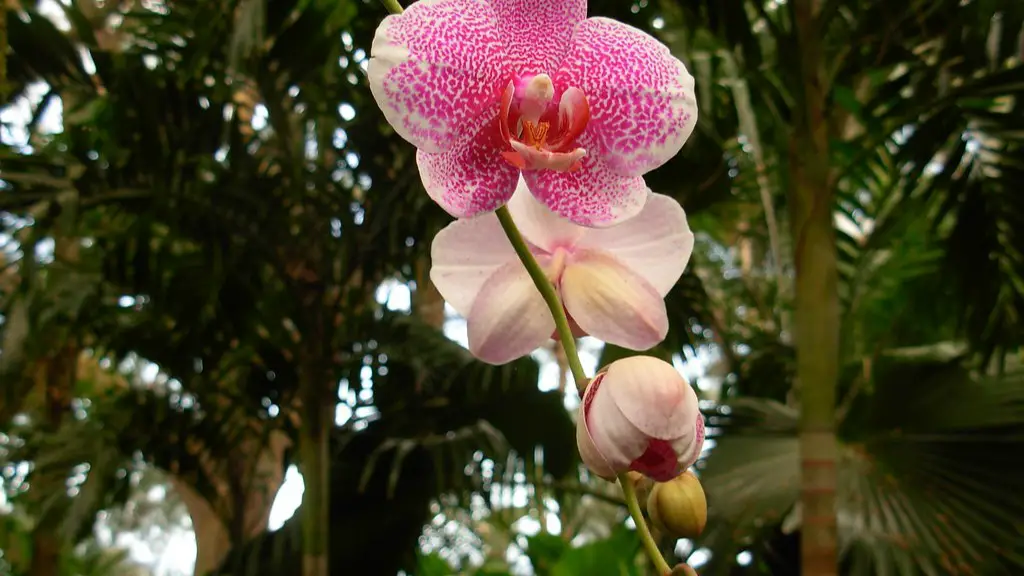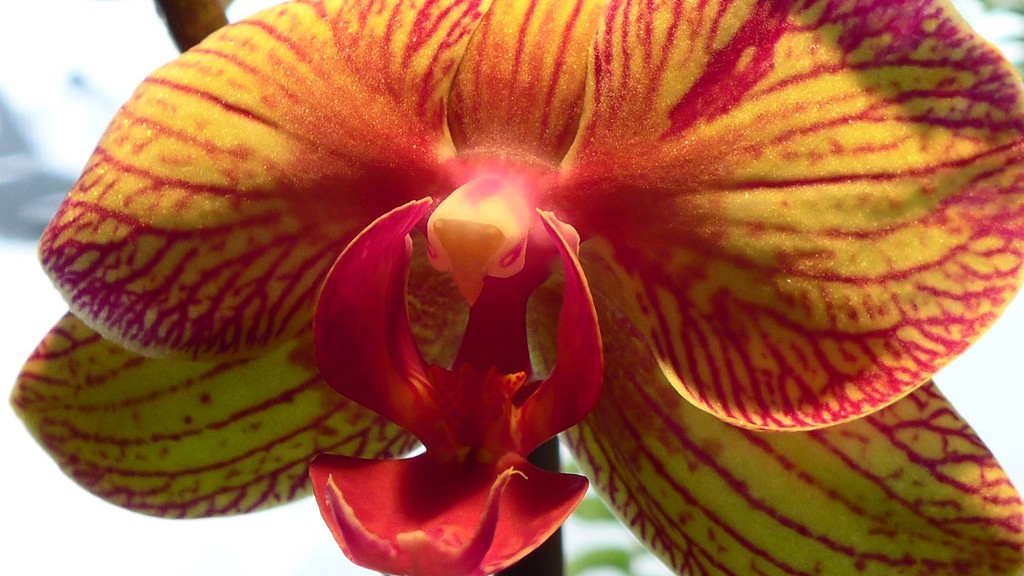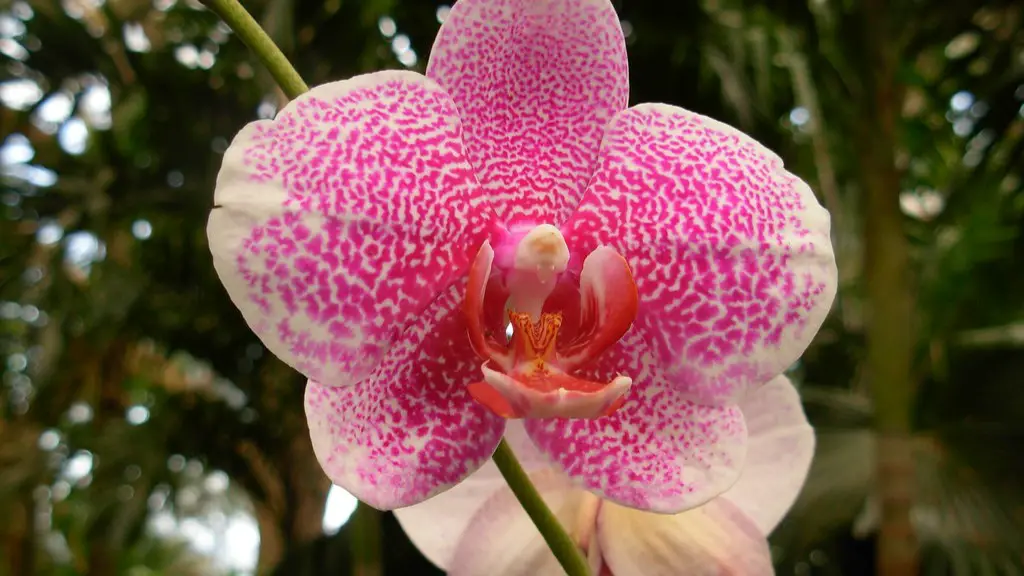Unfortunately, there could be several reasons why your Phalaenopsis orchid is dying. It could be due to too much or too little water, poor drainage, too much or too little light, or even a pest problem. If you’re not sure what the problem is, it’s best to consult with a professional.
The most common reason for a Phalaenopsis orchid to die is because of root rot, which is caused by too much water.
How do you revive a dying phalaenopsis orchid?
You can revive an orchid plant by repotting it in some fresh growing medium. First, cut back any dead leaves and stems. Next, remove the plant from its current pot and shake off any loose dirt. Once the plant is freed from its pot, inspect the roots. If they are white and healthy, the plant can be repotted. If the roots are brown and mushy, the plant may be too far gone to save.
To repot the plant, choose a pot that is only slightly larger than the current one. Fill the pot with fresh growing medium, such as bark chips or moss. Place the plant in the pot and gently pack the medium around the roots. Water the plant thoroughly and place it in a bright location out of direct sunlight. With a little care, your orchid plant will soon be blooming again.
If your orchid is dying, don’t despair! With a little bit of care, you can revive your plant and help it thrive once again. Here are five quick and easy steps to follow:
Step 1: Move your orchid to a new pot. If your orchid is in a pot that is too small, it will be difficult for the roots to get the air and water they need. By moving your orchid to a new, larger pot, you will give it a better chance to thrive.
Step 2: Give your orchid fresh potting mix. Over time, potting mix can break down and become compacted, making it difficult for roots to get the air and water they need. By replacing the potting mix, you will give your orchid a fresh start.
Step 3: Cut back your orchid’s stems. If the stems of your orchid are long and leggy, they are not getting enough light. By cutting them back, you will encourage the plant to produce new, healthier growth.
Step 4: Place your orchid in a south-facing room. Orchids need bright, indirect sunlight to thrive. A south-facing room will provide the ideal amount of light for
What does a dying orchid look like
If you notice that your plant’s leaves are yellow and faded, or that its roots are mushy, it may be dying. Dropped leaves and a loss of evergreenness are also signs that your plant is in trouble.
If you notice that your orchid’s leaves are looking limp or leathery, it is probably because it is overwatered. The existing leaves may begin turning yellow, and new leaves may look pleated. Usually a change in the leaves is the most visible warning sign that orchids give. To correct the problem, allow the soil to dry out completely before watering again.
Do orchids bloom again after dying?
Although it can be difficult to see your plants go through a dormant period, it is important to remember that they will bloom again. In the meantime, there are a few things you can do to help your plants. First, make sure to fertilize your plants regularly, either monthly or every other week. This will help them stay healthy and strong. You can also use a houseplant fertilizer or balanced fertilizer at half the recommended rate. This will help your plants get the nutrients they need without overloading them. Finally, make sure to keep an eye on your plants and check for pests or diseases. If you see anything, make sure to treat it immediately. By following these tips, you can help your plants stay healthy and strong until they bloom again.
The most common reason that plants die is due to overwatering or underwatering. Most people end up guessing about the plant’s watering needs and either overdo it or don’t do it enough. Even though orchids can go dormant, they also can die simply because plants do have a lifecycle and will die at some point, too.
What does an orchid look like when it needs to be repotted?
If you notice your orchid’s roots pushing the plant up above the rim of the pot or reaching out into the air, it’s time to re-pot. Orchids prefer a small pot, weaving their roots through the compost as they grow. But eventually they run out of room and need more space to breathe.
Most people believe that orchids should be watered when the roots are dry. However, there is no set rule for when to water your orchids. Some people water their orchids every week, while others only water them when the roots are dry. Ultimately, it is up to you to decide how often to water your orchids.
How long does it take to bring an orchid back to life
Your Phalaenopsis orchid will bloom for up to three months and then remain dormant for about nine months before reblooming again. To trigger reblooming, fertilize your orchid and move it to a cooler environment where temperatures are between 55 and 65 degrees Fahrenheit.
If you see any rotten or diseased leaves on your orchid, it is best to remove them. These conditions can spread and eventually kill your orchid, so it is best to remove them as soon as possible. Using sterilized scissors, cut out any rotten and discolored spots you see. This will help keep your orchid healthy and prevent the spread of disease.
What does an unhealthy orchid look like?
The most common sign of an unhealthy orchid is brown or mushy roots. This is an indication that the plant has root rot and is not getting the necessary nutrients and moisture it needs to survive. Another sign of an unhealthy orchid is very dark green leaves. This usually means that the plant is not getting enough light and needs to be moved to a location where it will receive more bright, indirect sunlight.
The microclimate of higher humidity is beneficial for preventing heat stress and aiding stressed plants in recovering. By creating a more humid environment, plants are better able to withstand high temperatures and recover from any heat-related damage.
What does a dehydrated orchid look like
If you see that your orchid’s bottom leaves are yellow and wilted, and its buds are falling off instead of opening, this is a sure sign that it is dehydrated. To revive your plant, water it thoroughly and then place it in a location where it will receive bright, indirect sunlight.
If roots are overwatered, they will become mushy and have very little substance. Orchid roots are generally only bright green right after they have been watered and will turn silvery green after a few days. If they are still bright green and you haven’t watered them recently, they may be getting too much water.
Is it better to bottom water orchids?
Orchids need a lot of humidity to thrive, and one way to provide that is to set the plant on top of a tray of pebbles and water. The evaporation of the water will help to humidify the air around the plant. Just be sure that the bottom of the pot is not touching the water, as this can lead to rot.
Orchids are a beautiful, unique type of plant that come in many different shapes, sizes, and colors. One of the great things about orchids is that they can be propagated from stem cuttings or by dividing the rhizomes. This means that if you have an orchid that you love, you can easily grow more of them! Plus, if you cut down a flower spike after the blooms have died, you can expect it to grow back. So there are many ways to enjoy these beautiful plants.
What month do orchids lose their flowers
It’s that time of year again where our Phalaenopsis orchids are getting ready to bloom! These lovely flowers typically bloom in the late winter through the spring, so if you’re looking to add a touch of color to your home during these colder months, these are the perfect plant for you. Keep in mind that once blooming has finished, usually around late June or July, the plant will need a little extra care. This is the ideal time to repot your orchid, as they will be going out of bloom and will need a fresh start.
If you want your orchid to rebloom, give it plenty of bright, indirect sunlight. The more light it receives, the longer its blooms will last and the greater its chances of reblooming.
Final Words
There are many potential reasons why your phalaenopsis orchid may be dying. Some possible causes include: too much or too little water, not enough light, too much fertilizer, or pests. If you can identify the problem and correct it, your orchid may start to recover. However, if the plant is already severely affected, it may not be possible to save it.
The most common reason for a Phalaenopsis orchid to die is due to lack of water. These plants need to be watered regularly, and if they are not, they will begin to wilt and die. Other reasons for death may include over- or under- watering, too much or too little light, and inadequate drainage. If you suspect your orchid is dying, try to correct the problem and see if the plant improves. If not, then it is likely time to let it go.




